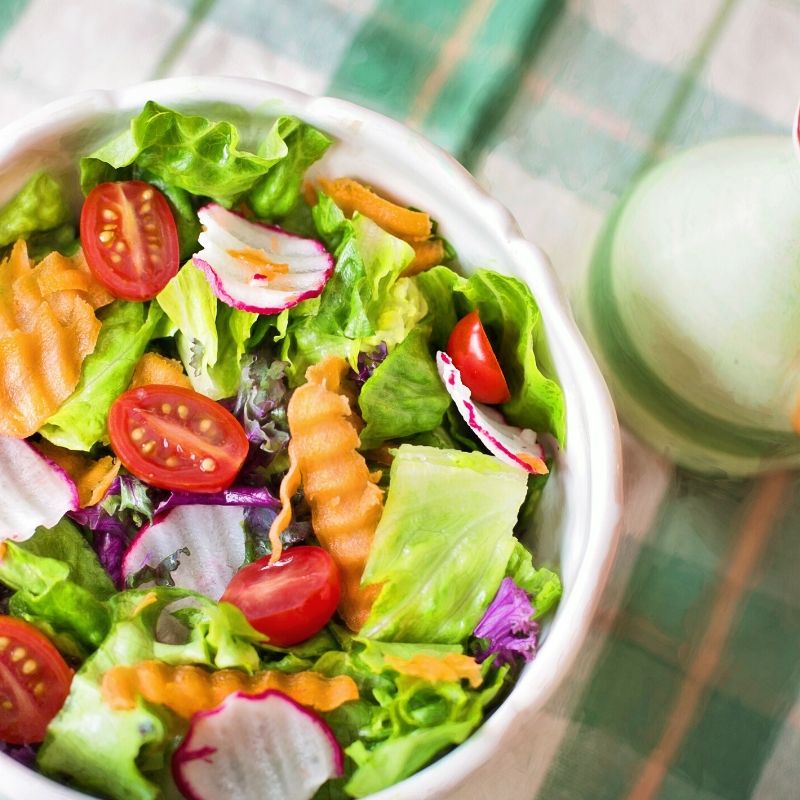Are you trying to eat healthier this year? With so many cooking oils out there, it can get confusing to know which ones to use and when to use them. For example, some oils are great for high heat cooking and others are only safe to use as cold or room temperature type food preparation. Do you know which oils to use, when, and how? The following is a handy guide featuring 10 Healthy Cooking Oils & How to Use Them, with a printable you can print out to hang on your refrigerator for easy reference!
10 Healthy Cooking Oils & How to Use Them
Healthier cooking is not difficult, it just takes a little knowledge and a different mindset. The most important things to remember when cooking healthy is using oils that have lower saturated and trans fats, higher monounsaturated and polyunsaturated fats, higher nutritional value, and its smoke point. When I started my journey to healthier eating, I discovered that I had been using several cooking oils all wrong and I was not using enough healthy oils.
As a long-time cook, I thought I had this healthy cooking thing all figured out but I didn’t and had to re-learn a few things. When my son came home for the holidays, I realized he did not know how to use oils correctly either, so I decided to create this guide for him and for all of you who get confused too. As a bonus, I created a printable version of it so you can print it out and hang it on your refrigerator!
Why Use Healthier Oils?
Why should you care what oils you use when you cook? For your heart and your brain, of course! ♥ Saturated and trans fats are bad fats; monounsaturated and polyunsaturated fats are good fats. In even more simple terms, bad fats raise bad cholesterol (LDL) and can raise your risk of heart disease and stroke. Good fats are good for you and raise your good cholesterol (HDL) which absorbs bad cholesterol and can protect your heart and brain.
The other important thing to know when using fats for cooking is its smoke point. The smoke point is the point at which the oil burns, burning the food you are cooking. The fat oxidizes, releasing toxic chemicals harmful to your body. Fats with a high smoke point are safer to use for high heat cooking because they do not reach their smoke point, while fats with a lower smoke point reach that point faster, usually before the ingredient you are preparing is finished cooking. Unfortunately, the fats with the highest smoke point are usually the “bad” fats (butter, bacon grease, etc), but there are several “good” fats that have a high smoke point too and I will concentrate my discussion on those good fats below.
It is important to note that some healthy fats have a low smoke point so should be used only in cold or room temperature cooking. Healthy fats with a medium smoke point can be used in cold, room temperature, or medium heat cooking. Save the high smoke point fats for sauteing or frying.
While it may be difficult and virtually impossible to eliminate all saturated and trans fats from your diet, if you want to live a longer healthier life, you should strive to minimize the bad fats and maximize healthy fats. it may seem daunting, especially if you are used to cooking a certain way, but with a few pantry switches and the 10 Healthy Cooking Oils & How to Use Them guide below, you can do this!
Which Fats are Healthy, Which are Not?
The general rule of thumb for fats is that if the fat can solidify at room temperature, it has higher levels of saturated and trans fats in it, usually animal-based fats such as butter, bacon, cream, and cheese. Plant-based fats such as olive oil, avocado oil, and grapeseed oil are lower in saturated and trans fats and higher in monounsaturated and polyunsaturated fats. Olive oil, especially virgin olive oil, not only has monounsaturated and polyunsaturated fats but has hydroxytyrosol, which protects your body from free radicals. When used with fresh vegetables, fruits, and fish, virgin olive oil is considered one of the best foods you can put into your body, a true superfood.
Below I feature ten oils to use in healthy cooking. There are other fats I do not feature, such as vegetable and canola oil. These oils have varying degrees of health benefits and can be used for high heat cooking, but for the purposes of this discussion, I will only discuss the ten healthiest and most versatile oils.
The Oils
Avocado Oil
While avocado oil does have a small amount of saturated fat, it is chock full of healthy monounsaturated fats, specifically oleic acid, the same heart-healthy acid found in olives and olive oil. Avocado oil also has many nutrients, including folate, potassium, Vitamin E & K, and antioxidants. Avocado oil has a smoke point of 520 degrees, making it great for high heat broiling and frying, such as these Cumin Roasted Beets. Because of its great flavor, it makes a great addition to cold and room temperature cooking such as salad dressings, as well as medium-heat cooking. This light, pleasant-tasting oil is one of the most versatile oils to use for healthy cooking.
Walnut Oil
Walnut oil has a low smoke point of 320 degrees, making it great for cold and room temperature cooking, but not good for medium or high heat cooking. Walnut oil has heart-healthy polyunsaturated fats as well as alpha-linolenic acid, otherwise known as omega 3 and Omega 6 fatty acids. Walnut oil has a strong nutty flavor so it should be used sparingly so as not to overpower the dish.
Grapeseed Oil
Made by pressing oil from the seeds of grapes, what grapeseed oil lacks in overall nutrients, it makes up for in Vitamin E, antioxidants, polyunsaturated fats, and Omega 6 fatty acids. Something to note about those Omega 6 fatty acids. Although too much Omega 6 can cause inflammation in some people, grapeseed oil contains linoleic acid, which has fewer inflammation properties. With a smoke point of 420 degrees, grapeseed oil is one of the cleanest oils to use for high heat frying.
Olive Oil
While olive oil in itself is one oil, there are two ways to use it.
Extra Virgin Olive Oil
Extra virgin olive oil or EVOO is an oil that is created by crushing olives then cold pressing them to create the oil. Since there is no heat used in the cold-pressing of the oil, it retains its natural flavor, monounsaturated fats (the really good fats) and nutritional value. EVOO is loaded with antioxidants, and Vitamin E & K. It is one of the healthiest oils you can use in cooking, but with a smoke point of 350 degrees, EVOO keeps most of its nutritional qualities when used for cold or room temperature cooking.
Refined Olive Oil
While still one of the healthiest oils to use in cooking, refined olive oil retains fewer antioxidants than EVOO but still has monounsaturated fats. Refined olive oil is processed similar to EVOO but uses lower quality olive oil that is heated to remove chemicals. Refined olive oil has less flavor and color than EVOO but with a higher smoke point of 465 degrees, it great for higher heat cooking.
Note: Both EVOO and refined olive oil are excellent choices for healthier baking.
Coconut Oil
Coconut oil is a fat that is healthy when used in moderation. It does contain higher levels of saturated fats, but those fats are medium-chain triglycerides, which means that your liver burns them faster and turns them into ketones, which are considered good for healthy brain function. Coconut oil is also supposed to help raise good HDL cholesterol, as well as improve the appearance of your skin and hair. Be sure to use organic virgin coconut oil, the purest form of coconut oil, not refined oil to get the health benefits. Coconut oil has a very smoke point of 350 degrees, so it should be used for medium heat cooking and baking only.
Safflower Oil
Safflower oil is easy to find at most grocery stores, and with a smoke point of 510 degrees*, it is a great multi-purpose oil to use for medium and high heat cooking, including frying. Safflower oil has monounsaturated acids which lower bad LDL cholesterol, raise good HDL cholesterol, and reduce inflammation. It also contains Vitamins A, D, E, and K.
Note: There are two types of safflower oil. High-oleic safflower is the type mentioned above and has a higher smoke point. Polyunsaturated safflower oil is also heart-healthy but has a lower smoke point and should only be used for cold or room temperature cooking.
Peanut Oil
Low in saturated fats, and with zero trans fat, peanut oil is packed with flavor, making it a great addition to your cooking oil roster. Just like olive oil, it is high in the monounsaturated fats that raise good HDL cholesterol, making it a heart-healthy choice. With a smoke point of 460 degrees, it can be used in all types of cooking, especially high heat frying, but also adds great flavor to salad dressings, but try to use cold-pressed peanut oil for the best nutrition benefits. Do not use for those who have peanut allergies.
Sesame Seed Oil
Sesame seed oil is high in polyunsaturated fats, omega 6 fatty acids, and antioxidants, and with a smoke point of 410 degrees, it makes a nice oil for a variety of cooking. Excellent in sauces and dressings, sesame seed oil does have a distinct flavor, a little goes a long way, so test it on small portions before adding it to whole dishes. Note: As sesame seed oil is cooked, it loses its flavor, so add it at the end of cooking to add an irresistible umami flavor to your dishes.
Flaxseed Oil
Flaxseed oil is super heart-healthy but with a very low smoke point of 225 degrees, it should only be used in cold or room temperature dishes. Flaxseed oil is known to lower inflammation, improve gut health, and support healthy cardiovascular function. Rich in Omega 3 fatty acids, protein, calcium, and magnesium, flaxseed oil can be a great substitute for those who do not like fish, and as one of the best sources of the phytonutrient lignan, it is a great source of fiber and antioxidants. Use it in salad dressings, drizzled over vegetables, or in baking.
Healthiest Oils for…
Baking
Avocado oil, olive oil (both kinds), coconut oil (sparingly), safflower oil
Frying
Avocado oil, grapeseed oil, refined olive oil, safflower oil, peanut oil, and sesame seed oil.
Sauteing
Avocado oil, extra virgin olive oil, coconut oil, peanut oil, sesame seed oil.
Salad Dressings
Avocado oil, extra virgin olive oil, flaxseed oil, a bit of walnut, peanut, or sesame seed oil for flavor.
Final Thoughts
If you must use butter in cooking, it is better to use grass-fed butter or ghee. My favorite grass-fed butter is Kerrygold and Vital Farms. (Not a paid endorsement) Look for a local organic dairy for your cream and butter.
Now that you know which healthy oils to use, what are you going to make? Make sure to print out this handy guide to remember which oils to use when! Click here —–> PRINTABLE GUIDE








